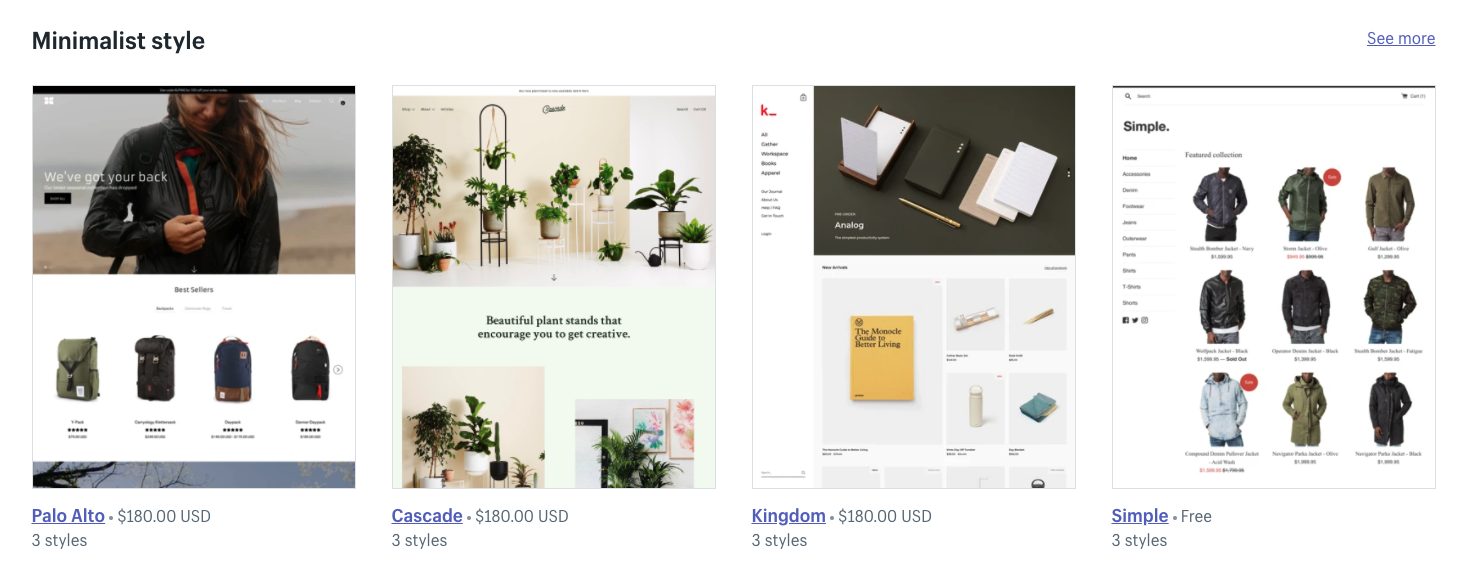There are now over 1 million active Shopify stores worldwide. The Canadian company thus holds 31% shares of the entire eCommerce market. This success probably stems from the fact that the platform combines everything and is suitable for any business. Whether it's the startup around the corner or the large corporation from Silicon Valley - Shopify offers an individual solution for everyone and is always at the cutting edge of technology. It is especially popular with eCommerce newbies because Shopify allows anyone, even without IT knowledge, to open a store in just a few hours.
How you can best prepare for Shopify store creation and what you should keep in mind when setting it up, you will learn in this post.
1. The right theme for your business
After you have successfully completed the registration process with Shopify, you need to decide on a theme. For this, you have a wide selection of themes available in the Shopify Theme Store. There are now over 70 free ones, while the rest are paid.

A selection of paid themes in the Shopify Theme Store
Before you blindly choose a theme purely based on visual impression, take some extra time to compare the different features. Also, look for stores that use your preferred theme and consider whether the theme fits your business.
During theme setup, you can then set your CI colors, insert logos and much more. You should gather this data in one place in advance so that your theme can be set up quickly.
2. Provide contact information
Whether you have a service business or sell your products online, contact information is always relevant because it builds trust. Moreover, contact information that can be found quickly increases customer satisfaction, even if something didn't go so smoothly. After all, customers can reach you quickly and easily, either via a contact form or your mail address.
Think in advance about which contact address you would like to provide. If you don't have a mail address for your business yet, this would be the right time to set it up.
3. Sufficient content on different pages
An online business builds itself step-by-step, yet you need enough photos, videos, blog posts and texts on different pages in your online store even in the beginning. Create visual appeal and tell a story so that customers love to buy from your store.
Here is a list of things you should prepare before your store goes live:
- Images, videos and product photos
- Page texts for the homepage, About Us, FAQ and Contact Us pages
- At least ten blog texts
With this, you have created a good basis for the sale. What's missing now are texts that legally protect you and your business.
4. Create legal texts
An "About Us" page is written quickly, but you should take a little more time for the legal texts. Especially the imprint and the privacy policy are important for the legal security of your store. In addition, you need a page on the general terms and conditions, the cancellation policy including a sample cancellation form, and information on payment and shipping.
If you have prepared these texts, you are on the safe side. We recommend using online tools such as Trusted Shops or consulting a lawyer who specializes in legal security in eCommerce.
5. Prepare product information
Besides product photos in different perspectives, you need enough information about your products. Especially dimensions, weight, material composition and origin are important. The information should be as detailed as possible, this way you will prevent customers from asking questions about the particular product and save a lot of time.
6. Set up value added taxes
Now it's not about information, but about important settings in your store. By setting the tax for the countries you want to sell in, you ensure that your customer pays their due tax when buying a product. In Germany, the tax rate varies depending on the type of product.
Here is more information on how to set up taxes properly on the backend.
7. Provide multiple payment methods

Shopify Payments offers you a convenient way to set up their payment methods.
You should set up different payment methodsin your Shopify store. The important ones in Germany are direct debit, credit card, PayPal, purchase on account and Sofortüberweisung. With Shopify Payments you can set up some of these options directly within Shopify, so you don't have to create multiple accounts with the respective providers.
8. Set up shipping and return policies
You've probably already given some thought to your product pricing. In the process, you should also determine the shipping costs. You can specify flat prices above a certain purchase value, standardized free shipping or different shipping costs based on the weight of the package.
Also important are the return policies. You need to set how the return will proceed, whether the customer has to pay for it himself or it will be offered for free. Return information should be well communicated in your online store.
9. Logistics
While we are on the subject of shipping, of course, planning logistics also plays an important role during the opening of an online store. After all, the goods should reach the customer as quickly, sustainably and efficiently as possible. If you don't plan to ship packages from your living room, you should look for a logistics partner in time that meets your needs. Warehousing1 helps you exactly at this point: Simply provide your project specifics and the industry experts will find the right solution for you.
Conclusion: The right preparation is key
So let's keep in mind: Proper preparation is key when setting up a Shopify store. If you already have all contact information, legal texts, images, product information, etc. ready, they only need to be inserted in the right places in the store. You should also take care of their payment options, shipping and return conditions and logistics. These are the key points that your Shopify store needs to fulfill so that it can go live soon and nothing is hindering a successful launch.
About the author
Inés Fabienne Gand is part of the marketing team at Eshop Guide. Copywriting, social media and content management are her specialties. She loves to spend her free time with her son, friends & doing yoga. For personal exchange you can find her on LinkedIn.www.eshop-guide.de



